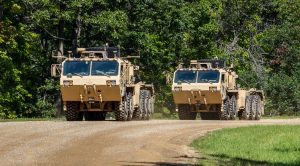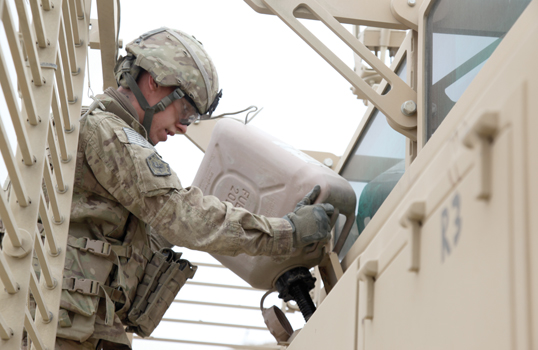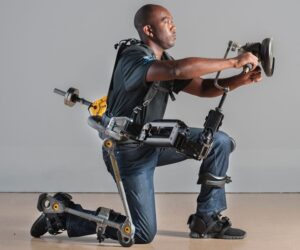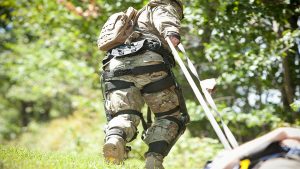Forget The Terminator: Robotics For Logistics 1st, Combat 2nd
Posted on
Despite heated talk of killer robots and powered armor, the unsexy truth is that artificial intelligence, robotics, and exoskeletons will be hauling ammo and helping mechanics long before they’re ready for frontline combat. So don’t think about the Terminator or Iron Man: Think about Sigourney Weaver’s power loader lifting crates in Aliens.
That may come as a relief for robophobes. But it also means the US military could benefit from high technology for lower-risk missions, today. Seizing this low-hanging fruit would streamline the support roles in the rear that take up most troops’ time, enabling faster deployment and more aggressive maneuvers — even as it helps refine the technology, concepts, and ethics for lethal frontline combat later.
[click here for Part I of this article, on how AI is essential for future Multi-Domain Operations]
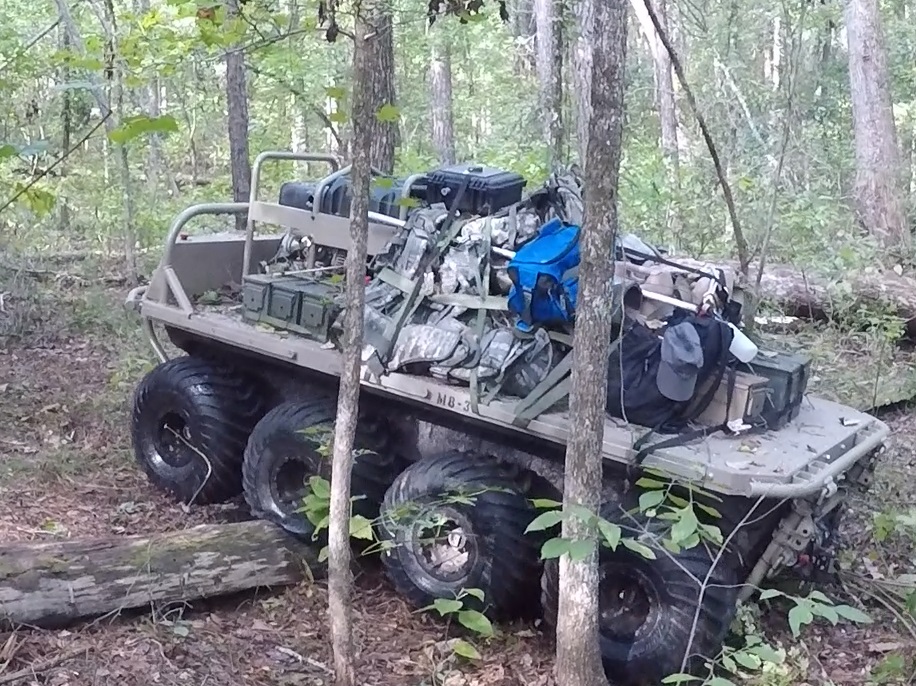
The General Dynamics contender for the Army’s new robotic mule, the S-MET (Squad Multipurpose Equipment Transport)
Professionals Talk Logistics
“There are a lot of great sustainment applications. We’re a ways off from close combat applications,” Brig. Gen. David Hodne told me as we rushed up several flights of stairs to his next appointment. (His pace left my joints and leg muscles aching for some exoskeletal support).
Hodne, the new director of the Army’s infantry modernization task force, was speaking specifically of human-wearable exoskeletons, but his remarks a few minutes earlier made it clear he felt much the same way about unmanned ground vehicles. The closest thing to a frontline robot in the works today is the Squad Multi-Purpose Equipment Transport, a kind of all-terrain robot golf cart meant to haul 1,000 pounds of ammo, water, and other supplies for foot troops — but to keep them from wandering off or getting stuck takes a lot of babysitters that a frontline unit can’t spare.
While the robotic vehicle itself is unmanned, Hodne said, “the S-MET as fielded right now, however, requires two soldiers to operate it, a leader and a follower.” Everyone wants robots to help the infantry, he told the first-ever AUSA conference on military AI, but “until you can solve the all-terrain mobility (problem) for robots, it is potentially going to hinder or limit the tactical mobility of the squad.”
So what applications might be doable right now?
“Predictive maintenance enabled by machine learning has been used by industry for a decade,” Gen. John “Mike” Murray, head of the newly created Army Futures Command, told the opening session of the AUSA conference in Detroit last week. That’s a reference to using large amounts of diagnostic data — often updated wirelessly in near-real time — to predict when engines and other components might fail, then tasking mechanics to replace or repair them first. This summer, the Army let a trial contract for predictive maintenance on M2 Bradley troop carriers.
Also in the near term, Gen. Murray continued, “TARDEC’s work on semi-autonomous (supply) convoys, better known as leader-follower, is among the Army’s most tangible and sophisticated AI applications.” While a manned vehicle has to blaze the trail, the robotic trucks can follow it thereafter without human guidance.
“Those are the primary areas where we’re starting, (e.g.) preventive maintenance,” Brig. Gen. Matthew Easley, head of the Army’s month-old AI Task Force, said in Detroit.
The AI inventory-management algorithms and warehouse robots that help Amazon deliver books and toilet paper, Easley said, can help deliver rations and munitions too, with the proper safety precautions. Compare to frontline combat, he said, “they’re easier problems, a little more constrained.”
Tooth & Tail
When most people think of the Army, they think of men with guns, not crates and wrenches. But in fact there are lots of logisticians, maintenance crews, ordnance technicians, and truck drivers, the “tail,” for every frontline combat unit, the “tooth.” That means rear-area efficiencies could save a lot of labor and money — and save a lot of lives by making support units smaller targets.
“Most of what the military does is things like logistics moving people and fuel and equipment and ammunition,” said Paul Scharre, an Army Ranger turned thinktanker. Scharre just completed an in-depth study of high technology, including robotics and exoskeletons, for the future infantry “super soldiers” — but, he told me, “the much nearer-term applications are in things like logistics.”
There are two big hurdles to frontline combat robots (think Terminator) and powered-armor exoskeletons (think Iron Man), Scharre and other experts say:
- One limit is that artificial intelligence, for all its rapid progress, is still pretty terrible at coping with uncertainty, ambiguity, and limited information — the very essence of frontline combat. The problem is doubly difficult for ground troops: Drones flying through empty air face a much simpler problem than robots rolling along on land, where mud, dust, and ditches bedevil AI long before an actual enemy shows up. And the machine-learning techniques that let computers beat humans at chess or go may not translate to the chaos of combat, where the playing pieces aren’t color-coded black and white, the terrain isn’t a nice flat grid, and your opponent doesn’t wait for you to take your turn.
- The second limit is that, while raw computing power doubles every 18 months as predicted by Moore’s Law, “there’s no Moore’s Law for batteries,” Scharre told me. The storage capacity of batteries, the energy output of electric motors, and the energy-efficiency of both robots and exoskeletons are all increasing, but incrementally, not exponentially. While that’s not a major issue for your iPhone, which just has to move data, it’s a big obstacle for robots and exoskeletons, which have to move actual physical objects. Sure, computers get more powerful every year, but the human body, fuel, and ammunition don’t get lighter.
You can get around these obstacles, however, if you start the technology out in carefully limited support roles, Scharre said. Current battery technology may only be able to power ground robots and exoskeletons for less than a full day — but at a fuel dump or ammo depot, unlike a forward patrol, you can just plug them into a diesel generator. Current AI may not be able to navigate around potholes or landmines without a human guide — but at a forward base, unlike the front line, you can just bulldoze the ground flat and mark obstacles with reflective tape or radio-frequency ID tags. And, of course, as with any new technology, robots and exoskeletons might break down unexpectedly — but in a maintenance unit, unlike an infantry squad, your mechanics are right there to fix it and the enemy isn’t right there to kill you before it’s fixed.
Step By Step
How soon can the military start using robots in the rear? Right now, said Scharre and many of the experts at the conference. In fact, as the Army converts supply trucks to run unmanned, it first has to install the same “drive-by-wire” controls found in today’s civilian cars and commercial trucks. Drive by wire enables features like remote monitoring of engine diagnostics — key for predictive maintenance — and automatic collision avoidance — a very basic form of AI taking over for the human driver. Such unthreatening safety and maintenance features can build comfort and experience levels for users, who in turn can provide invaluable feedback from developers maturing the technology further.
So the first robots will be converted trucks and other existing vehicles. But what about new machines with no equivalent in the Army today?
Think about an Amazon warehouse, with AI order-processing systems telling humans where to go and self-propelled shelves relocating themselves at need. “Robots are already being used in warehouses in commercial settings,” Scharre said,” so it’s totally reasonable to expect that there are opportunities today for the military to use robotics in logistics settings in the States or overseas.”
“Where we can use robotics right now?” said Robert Sadowski, chief roboticists at Tank-Automotive Research, Development, & Engineering Command (TARDEC), when I posed the question at the conference. One fairly simple thing private industry has been using for years that the military hasn’t explored, he said, is robot arms.
There’s tremendous potential there for “heavy-duty manipulation” to replace human labor. “There’s no reason I couldn’t load 20 tank rounds at once,” he said, instead of soldiers hauling each 50-pound shell individually: Imagine how much faster a tank could get back in action — without its crew having to get out and potentially expose themselves to fire.
“I could also look at automating refueling,” Sadowski continued. Robotic arms could replace human labor to manhandle heavy hoses and fuel bladders. In the longer term, small, mobile, and relatively expendable robotic fuelers could replace the convoys of manned tanker trucks that suffered so many casualties in Iraq and the centralized fuel depots that would prove tempting targets for, say, Russian drones and artillery. “If we have to fight dispersed,” Sadowski said, “we can’t have these huge tankers just sitting out there.”
“There are silos of excellence throughout DoD, in Amazon and other places, that have cracked this code,” said Bryan McVeigh, project manager for force projection programs at the Detroit Arsenal. “The challenge is how do I take that expertise and get it down to my 45 assistant program managers, because artificial intelligence isn’t just going on the things that go boom. I need to be able to put it into my bulldozers, my scrapers, my water purification systems, my transportation systems.”
As those near-term, non-combat applications refine AI, ground navigation, radar and laser sensing, and so on, McVeigh added, “those systems are going to be teaching us what we need to put in place (for the) Robotic Combat Vehicle.”
Subscribe to our newsletter
Promotions, new products and sales. Directly to your inbox.

